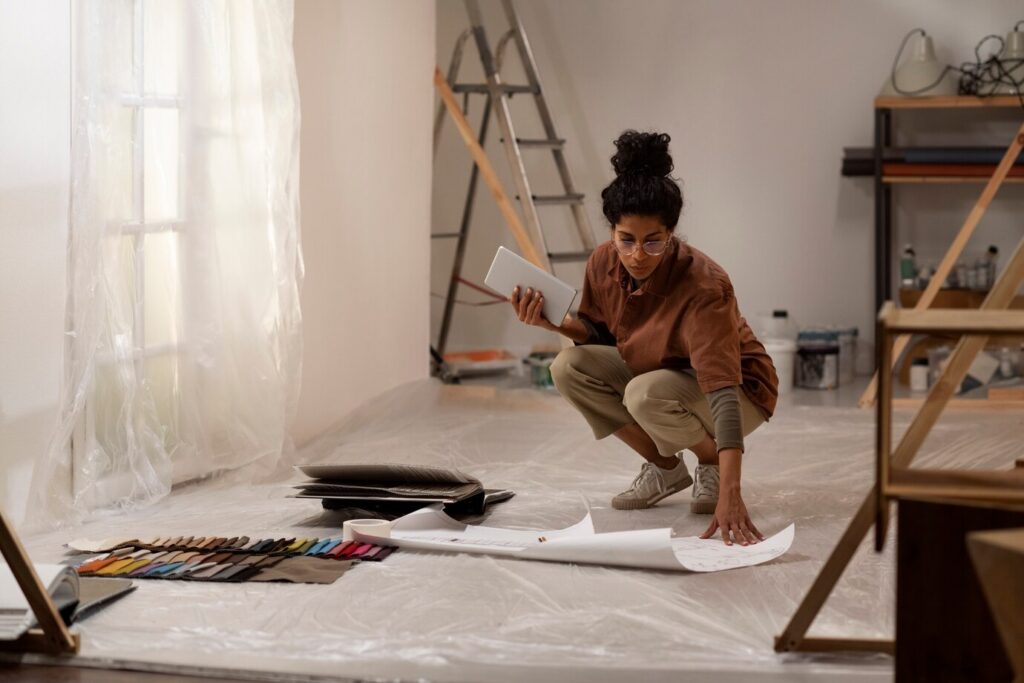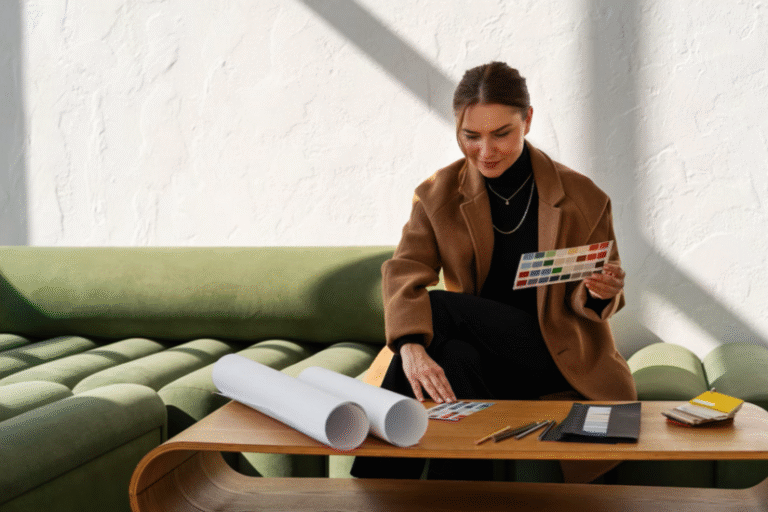Decorating might seem easy on the surface, pick some paint, hang a few pictures, and maybe throw in a nice wallpaper. But anyone who’s done it knows it’s part art, part technique, and a whole lot of prep.
Whether you’re refreshing a single room or styling an entire home, the secret to a clean finish often involves using the right tools and materials and also helps in developing spatial reasoning to identify where and how you should decorate a piece..
This beginner’s guide is here to help aspiring decorators understand what they need in their toolkits. From prep to paint to finishing touches, we’ll walk you through the essentials every decorator should have.
What Does A Decorator Do?
Decorators might:
- Paint walls and ceilings
- Hang wallpaper or wall coverings
- Choose color schemes and finishes
- Style furniture, fabrics, and accessories
While the eye for design is important, it’s the tools in hand that make the job clean, efficient, and professional.
Surface Preparation Tools

- 1. Dust Sheets and Plastic Covers: Keep floors, furniture, and fixtures protected from splashes and spills. Canvas drop cloths are durable, while plastic sheeting is lightweight and disposable.
- 2. Filling Knife / Putty Knife: Used to apply filler to cracks, holes, or dents in the wall. Flexible blades make smoothing easier.
- 3. Sandpaper or Sanding Blocks: Create a clean, smooth surface by removing old paint, filler ridges, or rough spots. Start with coarse grit, then move to finer grades.
- 4. Scrapers: Help remove peeling paint, wallpaper, or stubborn debris. Essential for renovation or repainting jobs.
- 5. Masking Tape / Painter’s Tape: Achieve sharp, clean edges where walls meet trim or ceilings. Also protects fittings and corners.
- 6. Cleaning Supplies: Dust, grease, or mildew can ruin your paint finish. Use cloths, mild detergents, or sugar soap to wipe surfaces clean before painting.
Painting Tools And Accessories
- 1. Paint Brushes: Used for cutting in around edges, corners, and trims. Different brush types include:
- Angled brushes – Perfect for trim and corners
- Flat brushes – Good for broad, even strokes
- Detail brushes – For touch-ups and precise work
- 2. Paint Rollers and Trays: Ideal for covering large, flat areas like walls and ceilings. Choose the right roller nap:
- Short nap (¼") – Smooth surfaces like plaster
- Medium nap (⅜"-½") – Lightly textured surfaces
- Long nap (¾"+) – Rough or textured surfaces
- 3. Extension Poles: Screw onto rollers to help reach high ceilings or large walls without ladders.
- 4. Paint Kettles and Pails: Portable paint containers that reduce mess and are easier to carry than full cans.
- 5. Stir Sticks and Openers: Stirring paint ensures even color and texture. Metal can openers avoid damaging the lid for future use.
Wallpapering Tools
- Wallpaper Paste Brush / Roller: Apply to the back of the wallpaper or wall, depending on the paper.
- Wallpaper Smoother or Brush: Bubbles and flush to the surface.
- Seam Roller: Seal seams and edges.
- Utility Knife: Trim edges, corners, and cut around sockets or frames. Sharp blade is key.
- Plumb Line / Spirit Level: Keep wallpaper straight from the start—especially with patterned paper.
Measuring And Marking Tools
- 1. Tape Measure: Walls, furniture, wallpaper lengths, and furniture placement.
- 2. Spirit Level: Lines, artwork, trims.
- 3. Pencils and Chalk Lines: Cutting lines, guide points, and outlines on walls.
Essential Decorating Materials
- Paint: Emulsion (walls), gloss (woodwork), satin (softer sheen). Match paint to surface and location.
- Wallpaper: Vinyl (easy to clean), fabric (textured), traditional paper (budget-friendly but delicate).
- Adhesives and Fillers: Filler, caulk, paste. Keep on hand for quick fixes and prep.
- Decorative Trims: Mouldings, cornices, panel trims.
- Fabrics and Accessories: Cushions, curtains, throws, soft elements.
Safety Equipment
- Gloves – Protect hands from paint, solvents, and adhesives
- Dust Masks – Prevent inhaling particles when sanding or painting
- Knee Pads – When working on floors
- Safety Goggles – Prevent paint, dust, or debris from getting in your eyes
Optional (But Handy) Tools
- Heat Gun – Speeds up paint or adhesive removal
- Laser Level – More accurate than a spirit level
- Paint Sprayer – Good for big areas or furniture makeovers
- Toolbox or Caddy – Keeps tools organised and portable
Building Your First Decorator’s Toolkit
- A basic paintbrush set
- A roller and tray
- Dust sheets
- Masking tape
- Filing knife and sandpaper
- Measuring tape and spirit level
Add tools as you go along and tackle new projects or learn new techniques. Focus on quality over quantity—cheap brushes shed bristles, and poor quality rollers leave streaks.
Conclusion
Decorating is a skill that combines creativity with physical work. But it’s not just about vision—it’s about execution. The right tools and materials will help you decorate faster, cleaner, and with more confidence. Whether you’re giving a bedroom a fresh coat or trying wallpaper for the first time, your toolkit is your best friend.
Take the time to learn what each tool does, practice with patience, and build your skills. Before long, you’ll be decorating and transforming spaces like a pro.
Frequently Asked Questions
Not at all. Start with the basics, like a few good brushes, rollers, tape, and dust sheets. As you gain experience or take on more complex projects, you can build out your toolkit over time.
Water-based emulsion paint is a great choice for beginners. It’s easy to apply, dries quickly, and can be cleaned up with water, making it ideal for walls and ceilings.
It’s possible, but not recommended. For best results, remove old wallpaper and properly prep the wall. If wallpapering over paint, make sure the surface is clean, smooth, and primed if needed.
Always wear gloves and a dust mask when sanding or using solvents. Use goggles when scraping or spraying. If working at height, ensure ladders are stable and floors are covered to prevent slips.



